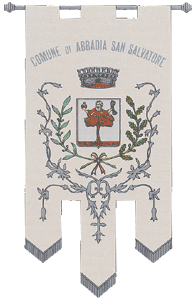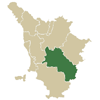|  Inhabitants in 1991: 7.243
Inhabitants in 1991: 7.243
 The
municipal territory of Abbadia San Salvatore extends for 58.92 square
kilometres on the eastern slopes of Monte Amiata and the valley of the
river Paglia. It had its origins as a Medieval monastic feudal; in
1777 it became capital of a very large community from which in 1867
were removed the districts of Campiglia d’Orcia, Bagni di San Filippo
and Caselle del Vivo, aggregated to the municipal of Castiglione d’Orcia. The
municipal territory of Abbadia San Salvatore extends for 58.92 square
kilometres on the eastern slopes of Monte Amiata and the valley of the
river Paglia. It had its origins as a Medieval monastic feudal; in
1777 it became capital of a very large community from which in 1867
were removed the districts of Campiglia d’Orcia, Bagni di San Filippo
and Caselle del Vivo, aggregated to the municipal of Castiglione d’Orcia.
The origins of Abbadia San Salvatore are tied to the same name Benedettina
Abbey founded in the middle of the VIII century by the Longobardo
Nobles Erfo; subjected to the authority of the Apostolic Seat and
contemporarily under Imperial protection, the Abbey already had means
to extend its territorial domain from Maremma to the Val di Chiana
at the end of the 700s. During the XII century around the Abbey the
habitat of Abbadia developed over which the monks exercised their jurisdiction.
But in contrasting events between the Abbey and the powerful Feudal Lords
Aldobrandeschi, determined to usurp the rights of the monks, the monastery
was forced to reorganise their possessions: of which the men of the Abbadia
castle took advantage and in 1212 after a brief period of subjection
to Orvieto, obtained a sort of autonomous municipal, while for
the crisis of the Benedettino order, in 1228 the Pope entrusted to Abbey
to the Cistercensi. It came into the possession of Siena after the battle
of Montaperti, at the beginning of the 1300s Abbadia was reconquered by
the Orvietani who ceded it to the Aldobrandeschi; and in 1347 it
was sold by them to the republic of Siena for 4,500 florins, then becoming
part of the Fiorentino State in 1559. During Fascism, the presence
of a working class developed, formed in prevalence by mine workers, which
established the reason for the tenacious struggle against Fascism. From
the second half of September 1943 when the Germans had already assumed
control of the coal mines, the first groups of partisans began to
establish themselves on the Armata, these supported the struggles of the
miners employed in acts of sabotage and of defence of the most important
structures from the German destruction.
Places to visit:
Medieval Village, exceptionally well preserved, it is an interesting
example of a mountain castle with Gothic and Renaissance houses.
Abbey of S. Salvatore, founded in 743 it became in a short
time the richest Abbey in Toscana. The church was reconstructed in
Romanic form in 1036. The Latin cross, single nave interior was remodelled
in 1590; it hosts precious works of art. The underlying Crypt is interesting,
it contains 36 columns with finely sculptured capitals. |
Historical info reproduced upon authorization of Regione Toscana - Dipartimento della Presidenza E Affari Legislativi e Giuridici
Translated by Ann Mountford |